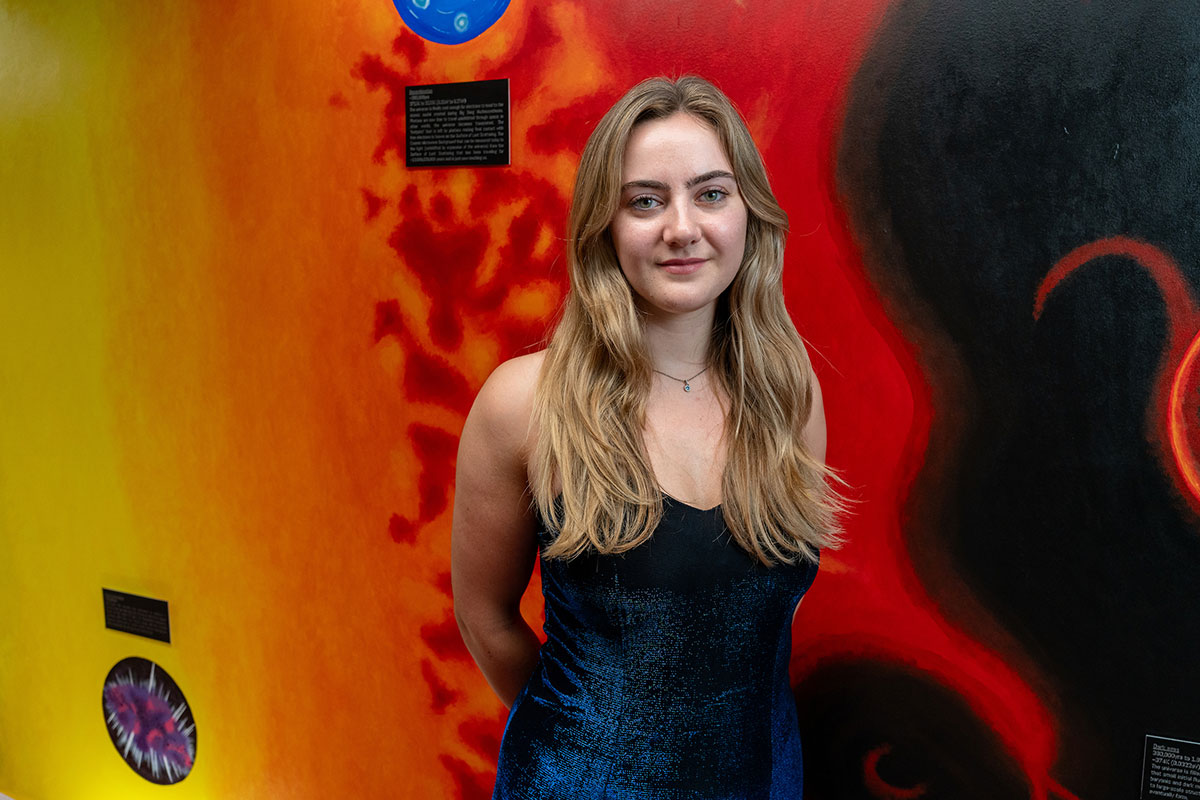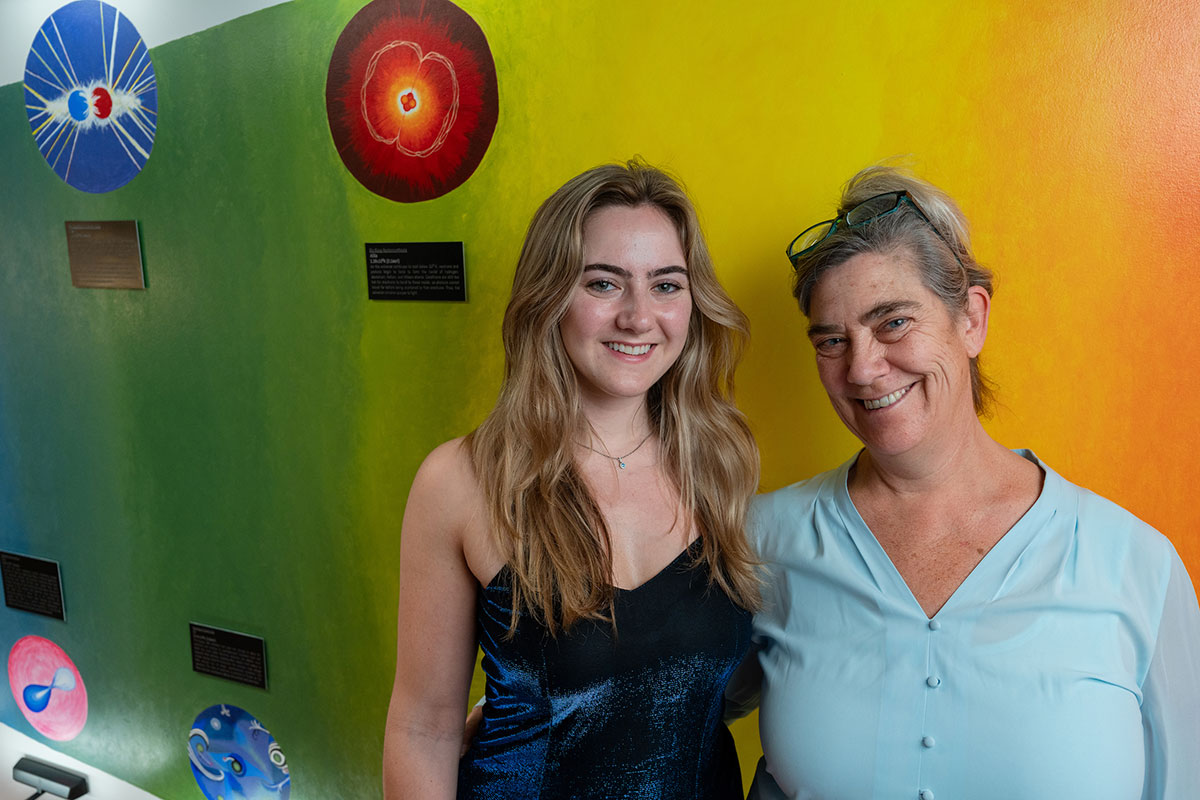
Eliza Hillenkamp ’24 stands in front of the mural she painted depicting the evolution of our ever-expanding universe.
If not for an open half-course slot in her junior-year schedule, Eliza Hillenkamp ’24 might never have painted the universe.
That empty space on her roster coincided with other forces, including the positive energy of her mentors and Hillenkamp’s gravitation toward big questions. What started as a Special Topics class on cosmology (the study of the origins of the universe) with Associate Professor of Astronomy Kate Follette rapidly expanded into a grand challenge: Could Hillenkamp learn cosmology and also interpret it, artistically?
The passageway to the Science Center’s telescope observation deck was bare. What if Hillenkamp filled its walls with a mural explaining how everything in our still-expanding universe came to be? Could one hallway tell a story 13.8 billion years in the making?
Hillenkamp decided to make it happen.

Visitors lean in to examine Hillenkamp's circular designs, which she called "bubbles," that depict distinct eras in the universe's development.
Before picking up a paintbrush, she spent months with her astrophysics textbook, absorbing theories of how the universe expanded from an infinitely hot and dense single point. “Because it’s impossible to recreate those early conditions in a lab, cosmology is a lot of statistics—definitely a lot of math I hadn’t learned before!” said Hillenkamp.
With her thesis adviser, Assistant Professor of Astronomy Mia de los Reyes, Hillenkamp taught herself about general relativity. With classmate Alex DelFranco ’24, she studied particle physics.
Then she began to sketch. Gradually, the sketches became circular designs, which Hillenkamp called “bubbles,” representing distinct eras in the universe’s development.
By the fall of her senior year, Hillenkamp was spending 12 hours a week painting, imaginatively translating the events that gave rise to the cosmos into visual concepts for her timeline-mural.
For many years, large-scale paintings by her mother, artist Christy Hengst ’89, had graced the basement of the old Merrill Science Center. (In 2010, Hengst’s traveling installation Birds in the Park had a one-day showing on the Amherst quad.) Said Hengst: “Growing up in Santa Fe, Eliza was around a lot of people who make things,” adding that Eliza’s father is an artist/blacksmith.

Eliza Hillenkamp ’24 with her mother, artist Christy Hengst ’89.
In the spring, while completing her senior honors thesis on wandering black holes, Hillenkamp continued to toil on the mural. She kept painting and perfecting her textual explanations for each era. “I tried to make it easy to understand, even for people who aren’t studying astronomy,” she said.
Professor de los Reyes, an observational astronomer who delights in connecting astronomy and physics with other fields, cited projects like Hillenkamp’s mural as the reason she wanted to teach at Amherst. “Studying the very early universe isn’t my area of research, so I’ve been learning as she’s been learning,” said de los Reyes. “Eliza has managed to so creatively capture a lot of the science. There are a lot of science facts buried in her ‘bubbles.’”
For example, the bubble depiction of the Quark Era was originally green and swirly to reflect the vorticity (or swirliness) of gluon plasma. As Hillenkamp learned more about the particles known as gluons, she added more hues. Gluons aren’t literally multicolored, but the mural introduces a gluon trait figuratively called “color,” which, Hillenkamp explained, is more like an atomic charge.
In Hillenkamp’s representation of Recombination—the moment when atoms first formed and light was finally able to travel unobstructed—a ring of buzzy atoms glow like fireflies against a deep blue backdrop. The cooling universe in effect became transparent, and its early light is just reaching us now. “This might have been the most important thing that happened in the early universe,” said Hillenkamp, “because it’s where we start being able to see back in time.”

During Commencement 2024, family, friends and campus visitors had the opportunity to explore Hillenkamp's mural, located in the passageway to the Science Center’s telescope observation deck.
Fast forward to the 2024 Commencement Weekend. Jess Martin, the Science Center’s administrative director, literally rolled out the red carpet for the debut of the mural—“to make it ‘pop’,” smiled Hillenkamp. The artist stood wearing a sparkling galaxy-blue dress, flanked by her proud parents, godfather and brother. Members of the milling crowd moved slowly from left to right, leaning in to read the engraved descriptions scattered across a wall now saturated with color and meaning.
“This mural shows the important events,” de los Reyes winkingly explained to visitors. “So humans are not on this except at the very, very end.”
“We are tiny and insignificant, but we’re also part of a system so large that we can’t even begin to comprehend its complexity,” said Hillenkamp. “People sometimes ask me if I feel despair [at] how extraordinarily vast the universe is, but I actually feel excitement. I think it’s really beautiful.”

Hillenkamp with her thesis adviser, Assistant Professor of Astronomy Mia de los Reyes.
Hillenkamp is spending this summer in Montana’s Glacier National Park, helping visitors explore breathtaking views of the cosmos from the Dusty Star Observatory. This fall, she begins a postbaccalaureate position at the National Radio Astronomy Observatory.
Hillenkamp has also been invited back to Amherst to paint a second mural—this one showing the possible future of our universe.